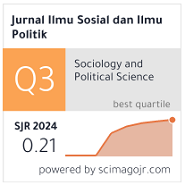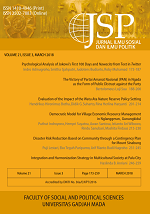Aging Labor and Japanese Industry Performance: Lessons for Indonesia Policies
Indri Dwi Apriliyanti(1*)
(1) Ph.D. candidate in International Management, School of Business and Law, Universitetet i Agder, Norway
(*) Corresponding Author
Abstract
This study analyzes the labor input factor that determines and shapes output generation in Japan. It hypothesizes that labor input contributes to the development of output growth in Japanese industries. In addition to that, it is hypothesized that moderator variable which is represented by numbers of aging labor can either stimulate or weaken the output generation. Hypotheses are tested using the data obtained from the Research Institute of Economy, Trade, and Industry (RIETI) Japan Industrial Output (JIP) Database 2011 and Japan Statistics Official within period 1970 to 2008. A multiple regression analysis, a manova and a hierarchical multiple regression analysis are conducted. Similar to expectation, aging labor has a negative moderating effect on labor-intensive industry; meanwhile aging labor has a positive moderating effect on capital-intensive industry. Not only does this study provide thorough knowledge towards output generation in Japan, but it also provides substantial lessons for Indonesia, particularly to enhance the industrial policy regarding the aging labor.
Keywords
Full Text:
PDFReferences
Abdel-Wahab, M., & Vogl, B. (2011). Trends of productivity growth in the construction industry across Europe, US and Japan. Construction Management and Economics, 29(6), 635-644.
Abikusno, N. (2005). The elderly in Indonesia: Current policy and programmes. Bold, 15(2), 18-22.
Adlakha, A., & Rudolph, D. J. (1994). Aging trends: Indonesia. Cross-Cultural Gerontology, 9(1), 99-108.
Aigner, D. J., & Chu, S. F. (1968). On estimating the industry production function. The American Economic Review, 58(4), 826-839.
Armstrong, J. S. (2011). Illusions in Regression Analysis. Retrieved from http://repository. upenn.edu/marketing_papers/173.
Beaudry, P., Colard, F., & Green, D. A. (2005). Demographics and recent productivity performance: Insights from cross-country comparisons. Canadian Journal of Economics, 38(3), 309–344.
Beck, N., & Katz, J. N. (1995). What to do (and not to do) with time-series cross-section data. American Political Science Review, 89(3), 634-647.
Becker, G. S. (1962). Investment in human capital: a theoretical analysis. The Journal of Political Economy, 70(5), 9-49.
Bird, K. (1999). Concentration in Indonesia manufacturing 1975–93. Bulletin of Indonesian Economic Studies, 35(1), 43-73.
Bloom, D. E., Canning, D., Fink, G. (2011). Implications of population aging for economic growth (Working paper No. 16705) . Cambrige, MA: National Bureau of Economic Research. doi:10.3386/w16705bg
Börsch, & Supan, A. (2003). Labor market effects of population aging. Labour, 17(s1). doi: https://doi.org/10.1111/1467-9914.17. specialissue.2
Bureau of Labor Statistics, T. (2012). BLS projections for the US labor market for 2010- 2020. Retrieved from U.S.
Cameron, L., & Cobb-Clark, D. A. (2005). Do co-residency with and financial transfers from children reduce the need for elderly parents to work in developing countries?. Retrieved from https://www.cbe.anu.edu. au/researchpapers/cepr/DP508.pdf
Carree, M. A., Klomp, L., & Thurik, A. R. (2000). Productivity convergence in OECD manufacturing industries. Economics Letters, 66(3), 337-345.
Chatterjee, S., Hadi, A. S., & Price, B. (2000). Regression analysis by example (Vol. 3). New York: John Wiley & Sons.
Christiaans, T. (2003). Aging in a neoclassical theory of labor demand. Retrieved from http:// hdl.handle.net/10419/83188
Cobb, C. W., & Douglas, P. H. (1928). A theory of production. The American Economic Review, 18(1), 139-165.
Coccia, M. (2009). What is the optimal rate of R & D investment to maximize productivity growth?. Technological Forecasting and Social Change, 76(3), 433-446.
Collinson, S. (2001). Dev eloping and deploying knowledge for innovation: Brit ish and Japanese corporat ions compared. International Journal of Innovation Management, 5(1), 73-103.
Colonia-Willner, R. (1998). Practical intelligence at work: Relationship between aging and cognitive efficiency among managers in a bank environment. Psychology and Aging, 12(1), 45-57.
Disney, R., Haskel, J., & Heden, Y. (2003). Restructuring and productivity growth in UK manufacturing. The Economic Journal, 113(489), 666–694.
Doeringer, P. B., Evans-Klock, C., & Terkla, D. G. (1998). Hybrids or hotchpotches? Workplace practices of Japanese and domestic start- ups in the United States. Industrial and Labor Relations Review, 51(2), 171-186.
Douglas, P. H. (1976). The Cobb-Douglas production function once again: Its history, its testing, and some new empirical values. Journal of Political Economy, 84(5), 903-916.
Fathin, C. A., Perdana, A. B., Kartikasari, A., & Sulistyani, D. R. (2014). Indonesian human resources readiness in term of facing the ASEAN economic community. Jurnal Ilmu Sosial dan Ilmu Politik, 18(2), 81-98.
Feyrer, J. (2007). Demographics and productivity. The Review of Economics and Statistics, 89(1), 100-109.
Gellert, P. K. (2010). Extractive regimes: Towards a better understanding of Indonesian development. Rural Sociology, 75(1), 28-57.
Gelman, A., & Hill, J. (2007). Data analysis using regression and multilevel/hierarchical models. New York: Cambridge University Press.
Gray, M. (2004). The social construction of the service sector: Institutional structures and labour market outcomes. Geoforum, 3(5), 23-34.
Gujarati, D. (2006). Essentials of econometrics 3rd edition. New York: Macmillan Publishing Company.
Ilmakunnas, P., & Ilmakunnas, S. (2010). Work force ageing and expanding service sector: A double burden on productivity?. The Service Industries Journal, 30(12), 2093-2110.
Imagawa, T. (2008). Trade and labor productivity effects on the changing structure of employment in Japan . Paper presented at the 16th Inforum World Conference, University of Lefke.
Ito, K., & Lechevalier, S. (2009). The evolution of the productivity dispersion of firms: A reevaluation of its determinants in the case of Japan. Review of World Economics, 145(3), 405–429.
Krugman, P. (1994). The Myth of Asia’s Miracle. Foreign Affairs, 73(6), 62-78.
Lincoln, J. R., & Nakata, Y. (1997). The transformation of the Japanese employment system nature, depth and origins. Work and Occupations, 24(1), 33-55.
Malmberg, B., Lindh, T., & Halvarsson, M. (2008). Productivity consequences of workforce aging: Stagnation or Horndal effect?. Population and Development Review, 34, 238-256.
OECD, T. (2011). Trends in retirement and in working at older ages, in pensions at a glance 2011: Retirement-income systems in OECD and G20 countries. Retrieved from http://dx.doi.org/10.1787/pension_glance-2011-6-en
Park, D., & Shin, K. (2012). Impact of population aging on Asia’s future growth. In P. Donghyu., S.-H. Lee, & A. Mason (Eds.), Aging, Economic Growth, and Old-Age Security in Asia (pp. 83-110). The Philippines: Asian Development Bank.
Prskawetz, A. (2006). The impact of population ageing on innovation and productivity growth in Europe Retrieved from Belgium:
Prskawetz, A., Fent, T., & Guest, R. (2008). Workforce aging and labor productivity: The role of supply and demand for labor in the G7 countries. Population and Development Review, 34, 298-323.
Remery, C., Henkens, K., Schippers, J., & Ekamper, P. (2003). Managing an aging workforce and a tight labor market: Views held by Dutch employers. Population Research and Policy Review, 22(1), 21-40.
Sato, R. (1970). The estimation of biased technical progress and the production function. International Economic Review, 11(2), 179-208.
Selmer, J. (2001). Human resource management in Japan: Adjustment or transformation?. International Journal of Manpower, 22(3), 235-243.
Shephard, R. J. (2000). Aging and productivity: Some physiological issues. International Journal of Industrial Ergonomics, 25(5), 535-545.
Silverstein, M. (2008). Meeting the challenges of an aging workforce. American Journal of Industrial Medicine, 51(4), 269-280.
Skirbekk, V. (2004). Age and individual productivity: A literature survey Vienna yearbook of population research (Vol. 2). Vienna: Vienna Institute of Demography of the Austrian Academy of Sciences.
Skirbekk, V. (2008). Age and productivity potential: A new approach based on ability levels and industry-wide task demand. Population and Development Review, 34, 191-207.
Souma, W., Ikeda, Y., Iyetomi, H., & Fujiwara, Y. (2009). Distribution of labour productivity in Japan over the period 1996-2006. Economics, 3(22), 1-17.
Solow, R. M. (1956). A contribution to the theory of economic growth. Quarterly Journal of Economics, 70, 65–94.
Statistic Bureau of Japan, T. (2012). Retrieved from http://www.stat.go.jp/english/data/ handbook/c02cont.htm
Suparjan. (2010). Jaminan sosial berbasis komunitas: Respon atas kegagalan Negara dalam penyediaan jaminan kesejahteraan. Jurnal Ilmu Sosial dan Ilmu Politik, 13(3), 249-274.
Swan, T. W. (1956). Economic growth and capital accumulation. Economic Record, 32, 334–361.
Tang, J., & MacLeod, C. (2006). Labour force ageing and productivity performance in Canada. Canadian Journal of Economics, 39(2), 582-603.
Tangen, S. (2002). Understanding the concept of productivity. Paper presented at the 7th Asia-Pacific Industrial Engineering and Management Systems Taipei.
Telegraph, T. (2014). World faces ageing population time bomb says UN. Retrieved from http://www.telegraph.co.uk/news/ worldnews/asia/japan/9579950/World- faces-ageing-population-time-bomb-says- UN.html
Tempo. (2013). Indonesia Trapped in De- industrialization: Indef. Retrieved from http://en.tempo.co/read/ news/2013/11/08/056528018/Indonesia- Trapped-in-De-industrialization-Indef
Timmer, M. P. (2002). Climbing the technology ladd er too fast? New evid enc e on comparative productivity performance in Asian manufacturing. Japanese and International Economies, 16(1), 50-72.
Verhaegen, P., & Salthouse, T. A. (1997). Meta-analyses of age-cognition relations in adulthood: Estimates of linear and nonlinear age effects and structural models. Psychological Bulletin, 122(3), 231-249.
World Bank, T. (1993). The East Asian miracle: Economic growth and public policy. New York: Oxford University Press.
World Bank, T. (2007). 10 years after the crisis, special focus: Sustainable development in East Asia’s urban fringe. Retrieved from http://documents.worldbank.org/curated/ en/679431468038153232/pdf/393720EAP1Update1April200701PUBLIC1.pdf
Article Metrics
Refbacks
- There are currently no refbacks.
Copyright (c) 2018 Jurnal Ilmu Sosial dan Ilmu Politik

This work is licensed under a Creative Commons Attribution-NonCommercial-NoDerivatives 4.0 International License.






















